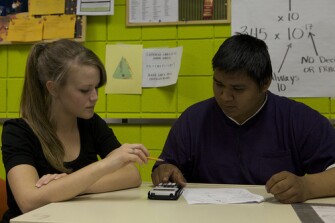
What is keeping girls from pursuing opportunities and careers in math? Certain barriers could be perpetuated by their teachers, a new study suggests.
Starting as early as kindergarten, teachers perceive boys’ math ability as higher than girls’, regardless of the students’ learning styles and levels of achievement, according to researchers from New York University, the University of Illinois at Urbana-Champaign, and West Chester University in a study published last week in AERA Open. This perception at such an early age could affect girls’ confidence and aptitude for math and prevent them from pursuing future STEM opportunities, the researchers wrote.
The findings come from data about gender gaps in math achievement and teachers’ perceptions of students’ abilities from two cohorts of students about a decade apart. The federal National Center for Education Statistics’ Early Childhood Longitudinal Program tracked students’ progress starting in kindergarten—a 1998-99 cohort from kindergarten to 8th grade and a 2010-11 cohort for whom data is now available for kindergarten and 1st grade. For both cohorts, teachers rated math ability on a 5-point scale, and also rated student behavior (such as behavioral problems and approaches to learning like self-direction and persistence) on two additional scales.
The takeaway: Throughout the last two decades, gender gaps in math achievement continued to persist, and teachers continued to rate the math performance of girls lower than that of similarly performing and engaged boys.
Here are a few important findings:
- There is no gender gap in math when most students begin kindergarten: In the 2011 cohort, kindergarten students started out more or less equal in math proficiency (with the exception of students from higher socioeconomic backgrounds), but by 1st grade, the overall gender gap in math achievement grew and continued to expand through 2nd grade.
- For high-achieving students, the gap starts even earlier: In the fall of their kindergarten year, boys in the 2011 cohort had an advantage among the most accomplished students. Girls accounted for more than half of all kindergarten students above the 50th percentile in cognitive assessment, but that proportion dropped to only 33 percent of students above the 99th percentile. By the spring of 2nd grade, boys performed better than girls above the 15th percentile, and only 1 out of 5 students above the 99th percentile were girls.
- Teachers in both cohorts underrated girls’ skills: Even when both groups of students had the same past and current math achievement and behavioral ratings, teachers, for the most part, underrated girls’ math skills from 1st grade on, in all levels of achievement.
These findings contradict research in 2008 that found the gender gap does not exist on state exams. Girls in grades 2-11 do just as well as boys on state standardized math tests, according to the 2008 report. One possible explanation for the contradiction, according to the AERA study’s researchers, is that the longitudinal program may reveal gaps that state tests, which don’t include high-level questions where gender differences are most noticeable, would not.
The 2008 report could also have affected educators’ perceptions of the problem and “removed incentives for schools to address girls’ specific needs in math,” the researchers write. “Furthermore, it is not clear that societal and teacher perceptions of girls’ mathematics abilities have actually improved.”
Boys also find favor with teachers and parents in other STEM areas. A recent nationwide survey of more than 1,600 7th-12th grade students and about the same number of parents found that teachers are more likely to tell boys that they would be good at computer science—39 percent of boys heard that versus 26 percent of girls. Girls are also less aware of computer science learning opportunities and less confident in their abilities.
Just a couple of months ago, my colleague Liana Heitin wrote that girls’ lack of confidence about math begins when they are young. Fifteen-year-old girls are more likely to report feeling math anxiety than boys of the same age, according to the 2012 Program for International Student Assessment (PISA).
The researchers in this latest study call for more attention to issues of gender in science, technology, engineering, and mathematics.
“Examining early gendered patterns in math can shed new light on differences in young girls’ and boys’ school experiences that may shape their later choices and outcomes,” the researchers wrote.
The study shows the need to further unpack “the causes of early gender gaps in math, including the role that teacher expectations and students’ learning behaviors and problem-solving approaches may play in their development.”
Source: Image by Flickr user US Department of Education licensed under Creative Commons